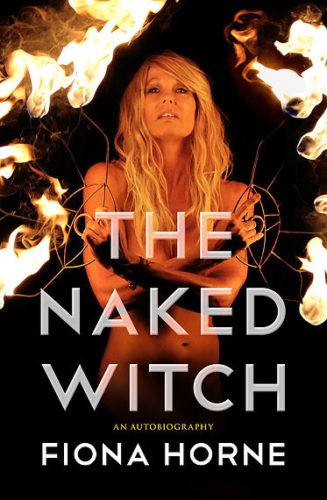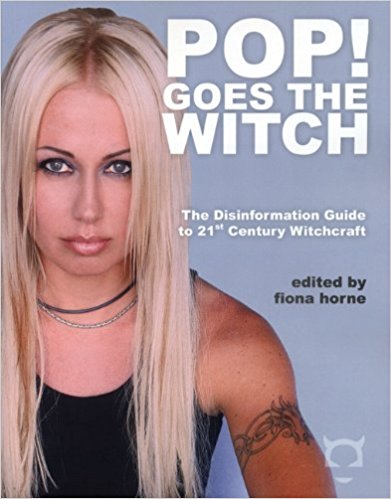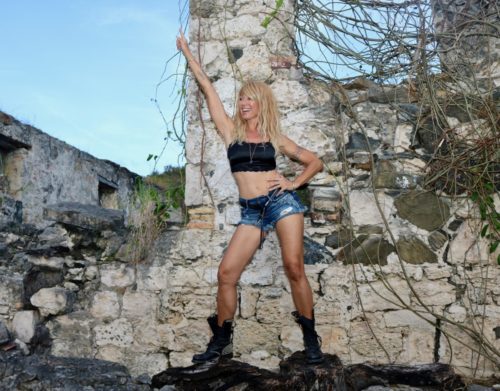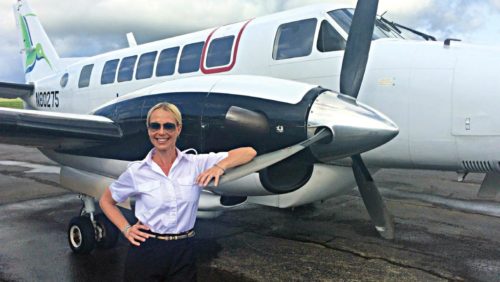ST. THOMAS, U.S. Virgin Islands — It’s not unusual for Tom Jones to sport a charm fashioned from a four-leaf clover, a piece of amber, and a bone from a fox penis. Well, at least the Welsh superstar singer was gifted such a charm by celebrity Fiona Horne, or “Fiona the Hot Witch,” as Ryan Seacrest once labeled her during a segment on E! News back in the early 2000s.
Those are just a few of the revelations in Horne’s new autobiography, The Naked Witch, which will be released in the U.S. Feb. 1. Horne chronicles her life before, during, and after her reign as “the world’s favourite Witch,” a self-description which, in the context of her book, comes across as matter-of-fact rather than pompous.
The “before” included low self-esteem issues, which she battled growing up as an adopted child in her native Australia, and which haunted her for many years. She writes about her feelings of being “a little Pagan” when, as a 10-year-old, she roamed the then-forested bush of suburban Sydney; her years fronting the rock band Def FX in the 1990s; her embrace of the “New Age Goddess movement and Witchcraft” through the writings of Starhawk, Z. Budapest, and others.
The “during” included her ascension as a celebrity Witch after she moved to Los Angeles in 2001. Soon, she writes, “I edged myself onto the U.S. mainstream entertainment radar, touting quirky, scary Witchcraft in the most friendly and marketable way” via her “Australian-accented, blonde subversion to the dominant paradigm of the evil Witch.”
That was also a period when, she writes: “As much as I increasingly received approval and acceptance as a Witch in the ‘muggle’ public eye, the Witchcraft community was hell bent on burning me at the stake (who needs Christians?) – attacks on my credibility and authenticity were rife.”
The “after” includes her current, quieter life as a Caribbean-based commercial pilot who frequently flies humanitarian aid missions.

Book cover [courtesy]
“I don’t know if it was a choice to make the book so – it just seemed like the appropriate thing to do,” the 51-year-old Horne said, her speech caressed by an Australian accent.
“Honestly, I wanted it to be an entertaining and engaging read, but most of all I hope that in writing very, very candidly about my life, that readers can benefit from all the times I got it wrong. I cried and I laughed writing the book, and it was more often tears of sorrow than tears of joy. I thought I had come to a place of reasonable peace and acceptance of myself, but I realized there was still some healing to be done, and that certainly happened for me in writing the book.”
Horne chronicles, briefly, the sexual abuse she endured from her grandfather, the emotional distance of her adoptive parents, and the many ways she would self-sabotage her efforts at school because she felt unworthy of success.
As a teen she kicked around in the grittier side of the Australian rock scene, flirting with heroin and speed, and surviving a “drug-induced psychosis.”
“I never put the needle in my arm myself,” she writes.
In the 1990s, she first tasted the spoils of celebrity life as the front woman of Def FX, an acclaimed band that combined hard rock with programmed dance beats. Soon she appeared in the Australian versions of Playboy and the TV show Celebrity Survivor, and she was hanging out with such rock and pop stars as Marilyn Manson, Billy Corgan, Tom Jones, and Gene Simmons and Paul Stanley of Kiss. From Stanley she received, as she writes, “the worst kiss I have ever had!”.
All the while, Horne notes, she was balancing the craziness of rock stardom and the celebrity world by immersing herself in Witchcraft and goddess spirituality, reading Starhawk’s The Spiral Dance and setting up her “mobile altar” in hotels while touring.
In 1998 she published her book Witch: a Personal Journey.
Even her Playboy shoot, as she notes in her autobiography, was a homage to the notorious Australian Witch, occultist, and artist Rosaleen Norton. When Horne was photographed naked in the front window of a bar in Kings Cross, they were recreating how a naked Norton would visit that very venue after a session as a nude model in the artist’s studio above.

book cover [courtesy]
She wrote such books as Witch: Magickal Journey, Witchin’: a Handbook for Teen Witches, and Magickal Sex: a Witches’ Guide to Beds, Knobs and Broomsticks. She edited Pop! Goes the Witch: the Disinformation Guide to 21st Century Witchcraft, and in one of its essays she wrote: “Rather than say a prayer at night, have an orgasm – alone or with your partner – and offer the energy to the Universe where it can be put to even more good use . . . virtually nothing beats using the energy of orgasm to fuel a spell to fruition.”
Horne became a hot ticket as a guest on numerous national TV shows and, as she writes, she was “regularly casting spells on KTLA 5 Morning News with now CNN darling Michaela Pereira, and handing out Hollywood Hexes at night on radio with Entertainment Tonight host Leeza Gibbons.”
Horne appeared as part of the cast of Mad Mad House, a reality TV show on the Syfy cable channel that featured 10 “normal” people living with five “alts”: a Witch (Horne), a vampire, a voodoo priestess, a naturalist and a modern primitive.
Then came the backlash from various Pagans, Wiccans, and Witches.“ ‘Fiona Horne is a fake – she just became a Witch to be famous,’ as multiple Pagan web nerds noted in their blogs critiquing my existence,” Horne writes in The Naked Witch.
These days such barbs no longer sting her.
“At the time I cared what people thought,” Horne said during the phone interview. “I don’t anymore (hearty laugh). Back then it seemed important and relevant. But you know, the day that I focused on compassion and forgiveness and also the day I stepped away from feeling answerable to people who thought to do things like that, it was a good, peaceful day.”

Fiona Horne [courtesy]
“The book talks about that time when my spiritual life had become so front and center of my job,”
Horne said during the interview. “I have the perspective now to be able to say that about the past. It felt different then. I felt like I had something to prove, like it was expected.”
She continued, “Like I said, I felt very answerable to people’s judgments. but I was like that ever since I was a kid, when I was getting bullied by kids at school. I think a lot of people can relate to it, where we feel like ourselves are not good enough. I hope that as people read the book, they think ‘Well, you know she was thinking like that and feeling like that, and I’ve felt like that.’”
In The Naked Witch, Horne writes that her desert python Lulu is her familiar, that she used her snake’s shed skin in spell work to get a new job, that the fox penis she used in her charm for Tom Jones was for virility, and that she had a visionary encounter with a talking hawk during the filming of Mad Mad House. Yet there’s not a profusion of nitty-gritty Witchy stuff in the book.
“It’s interesting you bring this up, because something that really no one knows — I guess you’ll get the scoop — is that the book originally had an appendix which was very much a how-to on Witchcraft, exploring the way that I practice now,” she said.
“The book was actually going to be called 50 Doesn’t Suck. An appendix was going to be called The Naked Witch — as in naked Witchcraft, no additives, no props, just raw real magic, you know,” she said.
“But in the end, the publisher was like, ‘Oh, The Naked Witch is a better title — you’re baring your soul. Let’s keep the appendix for another time.’ So there’s actually a big chunk of the book written that is very much how-to Witchcraft. There will be a book with more of the how-to in the coming months.”

Fiona Horne [courtesy]
After a stint in Alcoholics Anonymous, during which she discovered “I didn’t need to call myself an atheist Witch anymore,” Horne acquired a commercial pilot’s license and settled into her new single life in the Caribbean, flying chartered and humanitarian aid flights.
Yes, Horne is still a Witch. While she regularly attends the annual HexFest in New Orleans and fire dances at that gathering, most of her Witchy life manifests in and around her Caribbean home.
There she immerses herself in nature – “As I sit here right now, there’s a big, fat, green iguana in the tree next to me” — and she gives Tarot readings via Skype. Being a Witch “is everything, it’s just life,” Horne said. “I don’t have to separate it, and it’s not my job anymore which is great. I’m happy that’s not the case.”
She rode out both Hurricane Irma and Hurricane Maria at her home. She was without electricity for 121 days. She still has no Internet service.
“I live on an island and I’m up close and personal with nature every day,” she said. “The hurricanes — that was a really intense thing to go through as a Pagan. It was hard to understand how that much annihilation was necessary not once but twice in two weeks.
“I’m one of the lucky ones. I’m here. I lost friends in it. I tried to understand why nature needed to do this. Now it’s all green, and people who have lived here on this particular island for decades have said that there are plants growing that they haven’t seen grow in 20 years, that the hurricanes took away some of the smothering vines.”
Horne continued, “Prune, prune, prune — that’s what Mother Nature did with the two hurricanes. She pruned everything back to the rawest, barest bones and from there new life has sprung. So that’s the lesson. Sometimes out of the most catastrophic events comes the necessary new growth.
“But it hurts and you have to accept that death is essential for life. It is not pretty or glamourous the way that a lot of our community would think to glamourize it. It’s ugly and it smells and it hurts and it’s brutal. And from it comes life – that’s what you learn. That’s what being a Pagan Witch living on an island who works as a pilot is like.”
The Wild Hunt is not responsible for links to external content.
To join a conversation on this post:
Visit our The Wild Hunt subreddit! Point your favorite browser to https://www.reddit.com/r/The_Wild_Hunt_News/, then click “JOIN”. Make sure to click the bell, too, to be notified of new articles posted to our subreddit.
